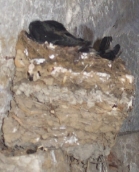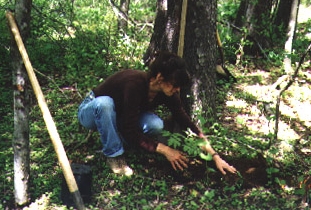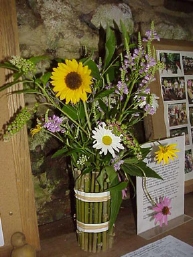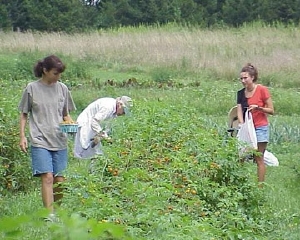 Barn Swallows
By Dawn Lawless
 I think we all have enjoyed watching the barn swallows return every year to make their nests in the barn at the farm. Where do they go in the winter? Aristotle proposed a theory suggesting that swallows overwintered in burrows in the ground. Actually they have one of the longest annual journeys of any bird. From North America to as far south as Argentina, the annual trip can be up to 7000 miles. They typically migrate during the day, while most other birds travel by night. I think we all have enjoyed watching the barn swallows return every year to make their nests in the barn at the farm. Where do they go in the winter? Aristotle proposed a theory suggesting that swallows overwintered in burrows in the ground. Actually they have one of the longest annual journeys of any bird. From North America to as far south as Argentina, the annual trip can be up to 7000 miles. They typically migrate during the day, while most other birds travel by night.
We've all seen their cup-like nests of mud lined with grass and feathers in the barn rafters and you've probably noticed their almost constant twittering and chattering. The female lays 4-6 eggs that are white with brown specks in her nest. Adult barn swallows are about 5-7 inches long, with deeply forked tails with streamers that allows them to easily swoop, glide or turn. If the streamers are short or non-existent then you are looking at a juvenile. As they are flying, they feed on insects that they catch on their wings. You can imagine that they must eat a great number of insects to store the energy necessary for their epic migration. We welcome them as an important part of our insect management system at Maysie's Farm.
Conservation Corner
By Amy Bruckner
Land Preservation — Conservation Easements 101
Ever heard the term Conservation Easement and wondered just what it meant? I will be addressing Land Preservation in a series of 3 articles, including a discussion of Conservation Easements, and options for property owners. Why would I want to do this? Well, I know there are lots of landowners out there who have no idea what Conservation Easements are and how they could work for them. Additionally, many landowners don't know what options are available to them besides wholesale development to glean value from their property or just keep their land in the family. This might pertain to you or someone you know or to whom you are related.
OK, I'll start with Conservation Easements and discuss options in the future. A Conservation Easement is a legal document in which a landowner agrees to permanently give up certain rights to preserve the environmental integrity of the land. It is recorded in the public deed records and is binding to any subsequent owners of the property. Simply put, this means giving up the rights to develop the property to its full potential under the applicable zoning.
Property owners can benefit from Conservation Easements not just by preserving the integrity of the land but also, if certain conditions are met, the property owner can receive a charitable deduction on their income taxes. These conditions are that the easement must be perpetual and donated to a qualified organization, such as a land trust, and it must meet one of the following standards: 1) conservation of land area for the general recreation or education of the general public, 2) protection of a natural habitat or ecosystem, 3) preservation of open space, or 4) preservation of a historically important land area or structure.
For Conservation Easements, current tax law allows a property owner a charitable deduction of up to 30% of their income with a 5 year carry over. The Senate recently passed legislation that will increase the charitable deductions for Conservation Easements and extend the carry over period, making the benefits more attractive in the future, if the legislation makes it way through congress. Stay tuned for discussions of options for property owners.
 |  |
| Charlene Briggs | |
|
Mark Your Calendars Now!
The Maysie's Farm Annual CSA Picnic will be held on Saturday, September 6, 2003 starting at 4:00pm (raindate: Sunday, September 7). Sign up to bring an appetizer, main dish, dessert, or something for the grill, then bring your family out for a fun time! Brian Moyer, who provides our chickens and eggs, will be providing entertainment with his band. The pool will be open, and we're planning some fun games and activities, as well as a 50/50 raffle.
Catherine Renzi is compiling a cookbook of members' favorite vegetable recipes to be distributed at the picnic. She's looking for more entries! Send yours to Catherine at cmrenzi2000@yahoo.com.
Save the date...you don't want to miss this event! We're looking forward to seeing you there!
|
Chard Swiss-Style
Louis P. De Gouy — The Gold Cook Book
Spinach or any other green may be prepared in this manner. If a sharper flavor is desired, half of the grated cheese may be Parmesan instead of Gruyere.
- 1 1/2 lb. chard leaves, parboiled for 5 minutes, thoroughly drained and coarsely chopped
- 2 slices firm, white bread with the crusts removed, broken into small pieces
- 1/4 cup milk
- 1 oz. dried mushrooms, soaked for 5 min. in warm water, squeezed dry and finely chopped
- 2 leeks, white parts only, finely chopped
|
- 3 tbsp. finely chopped fresh parsley or chives
- 1/2 cup finely chopped celery leaves
- 1 small garlic clove, crushed
- 1/3 cup grated Gruyere cheese
- salt and pepper
- freshly grated nutmeg
- 4 eggs
- 1 tbsp. butter
- 3 tbsp. olive oil
- 1/2 cup fine fresh bread crumbs
|
Place the bread in a mixing bowl and pour the milk over it, allowing it to stand until the milk is absorbed. Add the chard, mushrooms, leeks, parsley or chives, celery leaves, garlic and grated cheese. Season to taste with salt, pepper and nutmeg. Add the unbeaten eggs, one at a time, mixing well after each addition. Butter a baking dish generously, pour in 2 tbsp. of the olive oil, spreading well over the bottom of the dish. Mix the bread crumbs with the remaining olive oil. Spread the chard mixture evenly in the dish and top with the oiled bread crumbs. Bake at 350 for about 30 minutes, or until the mixture is firm and browned.
|

Picking cherry tomatoes

Sunflower

This handsome young fellow is still seeking a new home
|




